The Cattle Grooming Chute Market is estimated to be valued at USD 532.5 million in 2025 and is projected to reach USD 867.4 million by 2035, registering a compound annual growth rate (CAGR) of 5.0% over the forecast period.
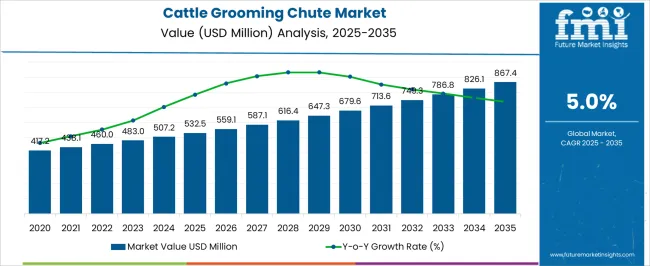
| Metric | Value |
|---|---|
| Cattle Grooming Chute Market Estimated Value in (2025 E) | USD 532.5 million |
| Cattle Grooming Chute Market Forecast Value in (2035 F) | USD 867.4 million |
| Forecast CAGR (2025 to 2035) | 5.0% |
The cattle grooming chute market is experiencing steady growth due to rising emphasis on livestock management efficiency, animal welfare standards, and the need for safer handling systems. Increasing herd sizes and commercial farming practices have elevated demand for durable and functional grooming chutes that simplify veterinary care, grooming, and regular inspections.
Technological enhancements in material design, portability, and chute adjustability are contributing to improved ease of use for farmers and handlers. Additionally, heightened awareness of hygiene and disease prevention in livestock has strengthened reliance on grooming chutes as essential equipment.
Market outlook remains positive as sustainable farming practices and mechanized livestock management continue to expand globally, creating opportunities for innovation in materials, design, and safety features.
The market is segmented by Size and Material and region. By Size, the market is divided into 6 Feet, 7 to 8 Feet, and Above 8 Feet. In terms of Material, the market is classified into Aluminum and Steel. Regionally, the market is classified into North America, Latin America, Western Europe, Eastern Europe, Balkan & Baltic Countries, Russia & Belarus, Central Asia, East Asia, South Asia & Pacific, and the Middle East & Africa.
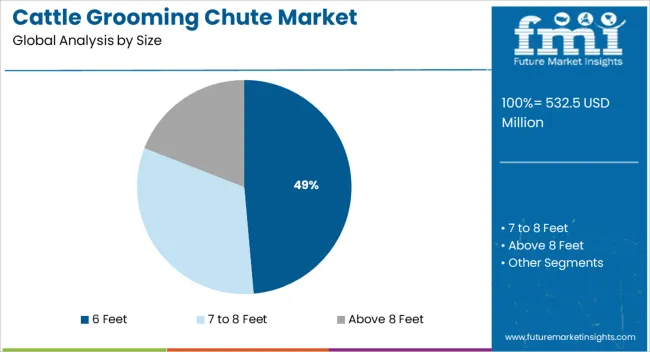
The 6 feet size segment is projected to account for 48.60% of the overall market by 2025, making it the leading size category. Its dominance is attributed to the suitability of this dimension for accommodating a wide range of cattle breeds while ensuring operator convenience.
The balance between compact design and functional capacity has made the 6 feet variant particularly popular among medium and large scale farmers. Its ease of installation, storage, and adaptability to grooming and veterinary tasks has reinforced its adoption.
With the growing need for efficient handling solutions that optimize space and provide safety for both animals and handlers, the 6 feet size segment has emerged as the preferred choice in the market.
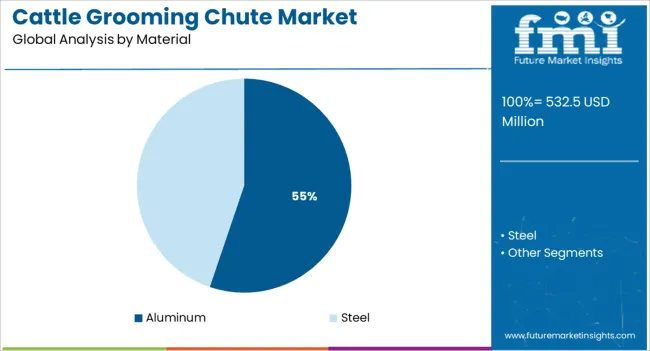
The aluminum material segment is expected to hold 55.20% of market revenue by 2025, positioning it as the dominant material category. This leadership is supported by aluminum’s lightweight nature, corrosion resistance, and durability, which enhance operational efficiency and longevity in demanding farm environments.
The material’s ease of transport and handling makes it more practical compared to heavier alternatives, reducing labor effort during setup and relocation. Additionally, aluminum grooming chutes offer a cost effective solution by lowering maintenance needs and extending product life cycles.
As farms continue to prioritize equipment that delivers both resilience and mobility, the aluminum material segment maintains its strong presence in the cattle grooming chute market.
The cattle grooming chute market is projected to expand exhibiting a CAGR of 5% between 2025 and 2035. Historically, the market value of cattle grooming chutes presented moderate growth from 2020 to 2025, registering a CAGR of 4.5%.
Selecting a cattle based only on its genetics is not how ranchers see bestowing animals. The time devoted to grooming and maintaining the cattle's appearance is of utmost importance. Cattlemen do this by tying a rope around the head of the cattle and fastening it to the grooming chute's rear bars. As a result, ranchers prefer using cattle grooming chutes since they assist them to start grooming the cattle while keeping it comfortable.
Short Term (2025 to 2029): Maintaining cleanliness among the cattle is essential due to an increase in the different kinds of illnesses tUhat afflict them. This is anticipated to lead to a rise in the adoption of cattle grooming chutes.
Medium Term (2029 to 2035): During this timeframe, manufacturers are likely to witness a rise in the popularity of cattle grooming chutes. The trend of long-term modifications in herd management for providing quality care is likely to stimulate this popularity.
Long Term (2035 to 2035): The adoption of cattle grooming chutes is projected to expand rapidly during the period. This is primarily because of the growing tendency to upgrade existing expensive or challenging-to-repair parts equipment with modern cattle handling systems.
These factors are anticipated to support a 1.6X increase in the market between 2025 and 2035. The cattle grooming chute market is projected to be worth USD 867.4 million by the end of 2035, according to FMI analysts.
| 2020 | USD 353.7 million |
|---|---|
| 2024 | USD 440.3 million |
| 2025 | USD 460 million |
| 2025 | USD 483 million |
| 2035 | USD 867.4 million |
Depending on several variables, there is an increasing preference for modern cattle washing approaches such as cattle grooming chutes. This aids in maintaining their overall health by keeping an eye on cattle behavior, identifying diseases, and properly cleaning the cattle. Agriculture-based economies are set to provide cattle grooming chute market players with lucrative opportunities in the upcoming years.
The increased demand for cattle handling and grooming systems provides manufacturers with a chance to offer a wide range of tools and cutting-edge solutions. The rise of industries based on agriculture in the Asia Pacific region is anticipated to drive market growth over the forecast period.
The industrialization of cattle farming is expected to result in the implementation of innovative management practices including the cattle grooming chute. Farmers' and ranchers' recognition of the high level of safety and security is another contributing factor to the expansion of the cattle grooming chute market.
The market potential is expected to increase with more public-private finance, investments, dairy farming, and technology advancements. Market possibilities would also be created by an increase in the trend of government support for dairy farm efficiency projects and expansions. Farm owners are also becoming more cognizant of equipment improvements. It is also envisaged that using technology in the cattle handling system would open up new economic prospects for cattle grooming chute market players.
One of the recent astonishing inventions is the introduction of the autonomous catch-chute. This automated ACE closes the head gate and activates the squeeze when it detects an animal entering the chute using sensors. The operator handles the cattle, gives them implants, and provides immunizations all at once. Since it requires less effort during handling and provides a hands-free method of managing cattle, this cutting-edge equipment is likely to assist farmers in operating effectively.
| Country | Market Value (2025) |
|---|---|
| United States | USD 140.3 million |
| Germany | USD 87.5 million |
| United Kingdom | USD 43.2 million |
| China | USD 39.8 million |
| Japan | USD 24.4 million |
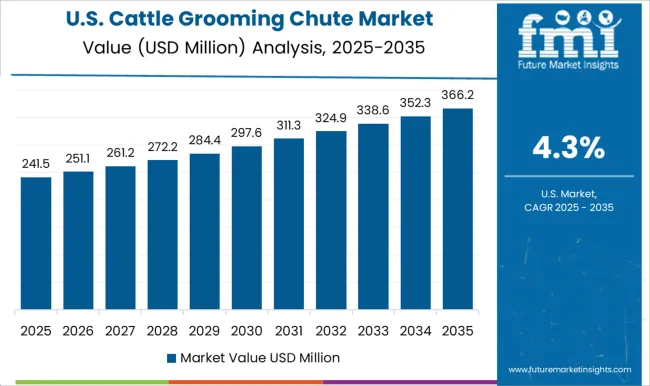
The expansion of dairy farms and rising labor costs have had an impact on the deployment of cattle grooming chutes in the USA. The usage of cattle chutes has been well-known in recent years as a result of increased professional exposure. The increasing usage of cutting-edge equipment and the compelling need to lower the cost of farming methods are expected to drive the growth market.
| Country | Market Share (2025) |
|---|---|
| United States | 30.5% |
The likelihood of zoonotic illnesses spreading to humans remains a concern given that there are around 507.2 million cattle in the USA as of 2024. Therefore, it's crucial to keep the cattle healthy and in good hygiene. This element is expected to boost the adoption of cattle grooming chutes in the country.
Agricultural subsidies and price support are two ways that the USA government helps local farmers and ranchers. These programs are designed to support them in keeping their businesses and their ability to compete in the market. Owing to the increasing demand for meat and milk in addition to the adoption of advanced modern equipment, the USA cattle grooming chute market has great prospects.
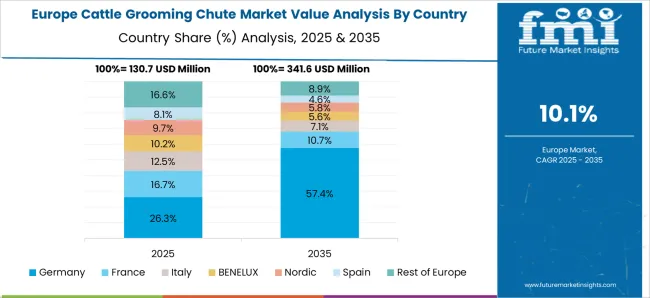
In the German dairy sector, lameness is considered one of the complicated issues. A significant problem with animal welfare arises from the lesions that make dairy cattle lame. Stress, which weakens and lowers productivity, is another side effect of lameness. Therefore, ranchers pay particular attention to cleanliness to stop the spread of lameness. Cattle grooming chute adoption is therefore anticipated to rise as a result.
| Country | Market Share (2025) |
|---|---|
| Germany | 19% |
The German cattle grooming chute market is the biggest in entire Europe owing to technological advancements and innovations in the field of dairy herd management. The nation's appetite for dairy and meat products is rising. The consumer preference for a diet high in protein is the cause of the rapid increase in consumption. A disciplined dairy industry and rising cattle productivity also bolster market expansion.
Cattle virus outbreaks are a typical phenomenon in the United Kingdom. Therefore, cattle should be cleaned and groomed often to get rid of the dirt and bugs in their bodies to prevent infection. Cleanliness in dairy farms safeguards the welfare of the animals as well as boosts productivity and revenue.
| Country | United Kingdom |
|---|---|
| CAGR (2025 to 2035) | 5.4% |
| Market Share (2025) | 9.4% |
| Market Value (2035) | USD 72.8 million |
The existence of oriented companies and increasing agricultural machinery import and export volumes are likely to enlarge the United Kingdom cattle grooming chute market. Growing health consciousness is anticipated to benefit the industry. This, in turn, is expected to increase the adoption of dairy farming equipment, including cattle grooming chutes.
The cattle sector has significantly improved in China. Government support, livestock supply and demand, and technological breakthroughs all have a positive impact on this trend. China published the National Food Safety Standard Code of Hygienic Practice for Livestock Farming in December 2020.
| Country | China |
|---|---|
| CAGR (2025 to 2035) | 4.0% |
| Market Share (2025) | 8.7% |
| Market Value (2035) | USD 59.1 million |
China is the largest producer of livestock in the world. On the other hand, the rise in population and per capita income has resulted in a tendency toward protein-rich food consumption. Therefore, the country is increasing its concentrated livestock production rapidly to meet the demand. China is the world's largest consumer of cattle farming equipment as well, with an estimated 1.1 billion cattle living there.
Farmers, ranchers, and agribusiness supervisors in the nation focus on precise and disciplined operations. They concentrate on prospective handling and grooming improvements in addition to management or relevant KPIs. As a result, the Chinese grooming chute market offers several prospects for industry participants.
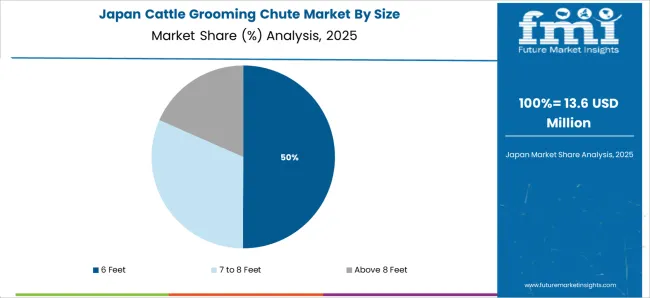
The livestock production sector is now rapidly growing in Japan. Since the 1960s, cattle farming for beef has grown to be a key aspect of Japanese agricultural production. In Japan, cattle were regarded as an "agricultural treasure." This is anticipated to increase the consumption of livestock farming equipment by farm owners. As a result, market participants in Japan are likely to get a huge turnover.
| Country | Market Share (2025) |
|---|---|
| Japan | 5.3% |
Japan's well-known beef-raising zone is Matsuzaka. The extremely fat-marbled beef that Japanese customers enjoy is produced there. On the other hand, the spread of BSE and other cattle diseases is a severe concern for Japan. Matsuzaka cattle are kept in tiny stalls where they are lavished with care to keep them free from any illness. To give the meat the right texture, their bodies are cleansed and massaged daily. This is likely to influence the Japanese cattle grooming chute market over the forecast period.
Aluminum is the present and the future of molds for the agricultural sector since it weighs just one-third as much as steel. Farm owners prefer utilizing aluminum cattle grooming chutes because of their lighter density. It is also inherently non-corrosive and has a wide range of alloys to fulfill strength needs.
Aluminum cattle grooming chutes are expensive, but they are growing in popularity since they are durable and provide long-term value. Notably, due to the existence of several other entities, aluminum does not react with water under normal circumstances. Other advantages of aluminum include its ability to comply with environmental and emissions standards.
The quantity of cattle in the herd determines the size and complexity of a chute used to handle and groom beef cattle. Cattle ranchers need good handling facilities like grooming chutes if they are to perform recommended management practices. For effective labor utilization, a functional chute should be able to contain at least three heads of cattle. Therefore, farm owners prefer using cattle grooming chutes ranging between 7 and 8 feet. Ranchers also deem this size ideal since cattle don't attempt to jump over it.
Market fragmentation for cattle grooming chutes is apparent. The sector is extremely competitive, as seen by the large spectrum of active manufacturers. Companies in this sector are using a wide range of tactics to stay afloat amid the intense competition. Market players strive to improve the cattle grooming chute they already provide for sale in addition to creating new models.
YYK Barn:
Since 2003, YYK Barn has improved the lives of its consumers by offering high-quality, long-lasting farm and ranch items. Farmers can provide their cattle with the extreme care possible without breaking the budget thanks to its high-quality livestock equipment. The squeeze chute and other livestock equipment it uses have withstood the test of time and the environment.
REAL-TUFF:
REAL-TUFF, Inc. has made it a priority to offer cost-effective, high-quality cattle equipment since its founding in 1994. As a result of the company's personal use of the equipment on its own farms, it also continues to develop new products and upgrade its offerings.
Hi-Hog:
Previously, there was a substantial surge in demand for cattle and horse equipment from Hi-Hog. To provide top-notch products and services, Hi-Hog terminated its line of hog panels and concentrate on cattle and horse equipment. Owing to having larger production facilities, Hi-Hog expanded its product portfolio to include rodeo equipment, bison equipment, wellhead fence, bleacher seating, and more.
Zietlow Distributing Company:
Zietlow Distributing Company was founded in a remote part of Kansas in 1961. It aimed to address the demand for top-notch livestock equipment on its own farm and ranch. After a farmer or rancher initially identified a need for livestock equipment, the company eventually started making "on-the-farm" and started selling calls to other farmers.
Recent Developments
The global cattle grooming chute market is estimated to be valued at USD 532.5 million in 2025.
The market size for the cattle grooming chute market is projected to reach USD 867.4 million by 2035.
The cattle grooming chute market is expected to grow at a 5.0% CAGR between 2025 and 2035.
The key product types in cattle grooming chute market are 6 feet, 7 to 8 feet and above 8 feet.
In terms of material, aluminum segment to command 55.2% share in the cattle grooming chute market in 2025.






Our Research Products

The "Full Research Suite" delivers actionable market intel, deep dives on markets or technologies, so clients act faster, cut risk, and unlock growth.

The Leaderboard benchmarks and ranks top vendors, classifying them as Established Leaders, Leading Challengers, or Disruptors & Challengers.

Locates where complements amplify value and substitutes erode it, forecasting net impact by horizon

We deliver granular, decision-grade intel: market sizing, 5-year forecasts, pricing, adoption, usage, revenue, and operational KPIs—plus competitor tracking, regulation, and value chains—across 60 countries broadly.

Spot the shifts before they hit your P&L. We track inflection points, adoption curves, pricing moves, and ecosystem plays to show where demand is heading, why it is changing, and what to do next across high-growth markets and disruptive tech

Real-time reads of user behavior. We track shifting priorities, perceptions of today’s and next-gen services, and provider experience, then pace how fast tech moves from trial to adoption, blending buyer, consumer, and channel inputs with social signals (#WhySwitch, #UX).

Partner with our analyst team to build a custom report designed around your business priorities. From analysing market trends to assessing competitors or crafting bespoke datasets, we tailor insights to your needs.
Supplier Intelligence
Discovery & Profiling
Capacity & Footprint
Performance & Risk
Compliance & Governance
Commercial Readiness
Who Supplies Whom
Scorecards & Shortlists
Playbooks & Docs
Category Intelligence
Definition & Scope
Demand & Use Cases
Cost Drivers
Market Structure
Supply Chain Map
Trade & Policy
Operating Norms
Deliverables
Buyer Intelligence
Account Basics
Spend & Scope
Procurement Model
Vendor Requirements
Terms & Policies
Entry Strategy
Pain Points & Triggers
Outputs
Pricing Analysis
Benchmarks
Trends
Should-Cost
Indexation
Landed Cost
Commercial Terms
Deliverables
Brand Analysis
Positioning & Value Prop
Share & Presence
Customer Evidence
Go-to-Market
Digital & Reputation
Compliance & Trust
KPIs & Gaps
Outputs
Full Research Suite comprises of:
Market outlook & trends analysis
Interviews & case studies
Strategic recommendations
Vendor profiles & capabilities analysis
5-year forecasts
8 regions and 60+ country-level data splits
Market segment data splits
12 months of continuous data updates
DELIVERED AS:
PDF EXCEL ONLINE
Cattle and Sheep Disease Diagnostic Kits Market Size and Share Forecast Outlook 2025 to 2035
Cattle Feed Market Analysis - Size, Share, and Forecast Outlook 2025 to 2035
Cattle Squeeze Market Size and Share Forecast Outlook 2025 to 2035
Cattle Feeder Panels Market Size and Share Forecast Outlook 2025 to 2035
Cattle Head Catch Market Size and Share Forecast Outlook 2025 to 2035
Cattle Handling Systems Market Size and Share Forecast Outlook 2025 to 2035
Cattle Blower Market Size and Share Forecast Outlook 2025 to 2035
Cattle Mineral Feeder Market Size and Share Forecast Outlook 2025 to 2035
Cattle Feeder Market Size and Share Forecast Outlook 2025 to 2035
Cattle Management Software Market Size and Share Forecast Outlook 2025 to 2035
Cattle Supplies Market Analysis & Forecast for 2025 to 2035
Cattle Nutrition Market Analysis by Cattle Type, Nutrition Type, Application, Life Stage Through 2025 to 2035
Smart Cattle Market
Dairy Cattle Feed Market
Automatic Cattle Waterer Market – Trends & Growth Forecast 2025 to 2035
Pet Grooming Market Trends - Size, Share & Forecast 2025 to 2035
Men's Grooming Product Market Size and Share Forecast Outlook 2025 to 2035
Beard Grooming Products Market Size and Share Forecast Outlook 2025 to 2035
Men’s Grooming Products Market Size and Share Forecast Outlook 2025 to 2035
Mobile Grooming Services Market Size and Share Forecast Outlook 2025 to 2035

Thank you!
You will receive an email from our Business Development Manager. Please be sure to check your SPAM/JUNK folder too.
Chat With
MaRIA